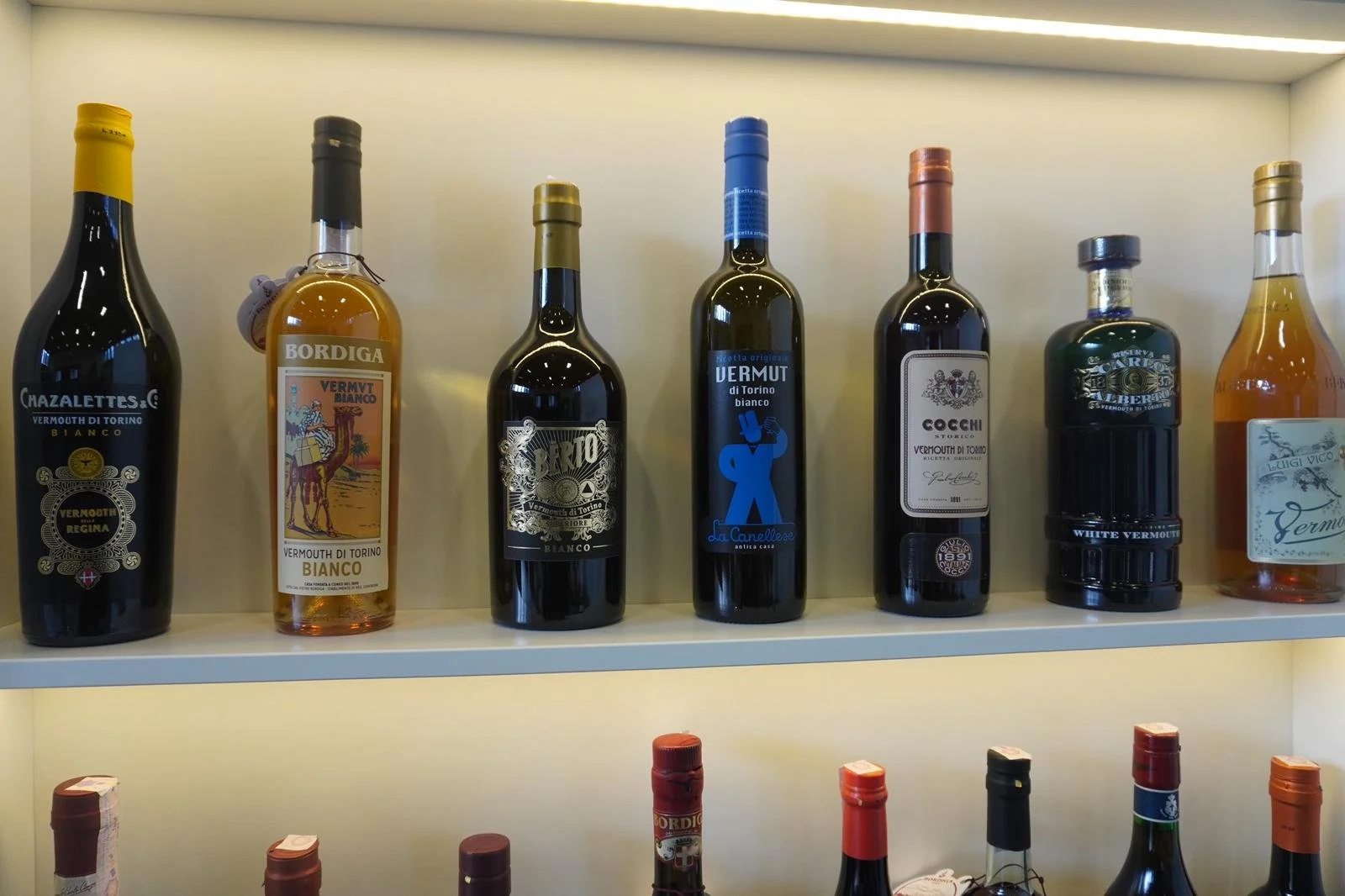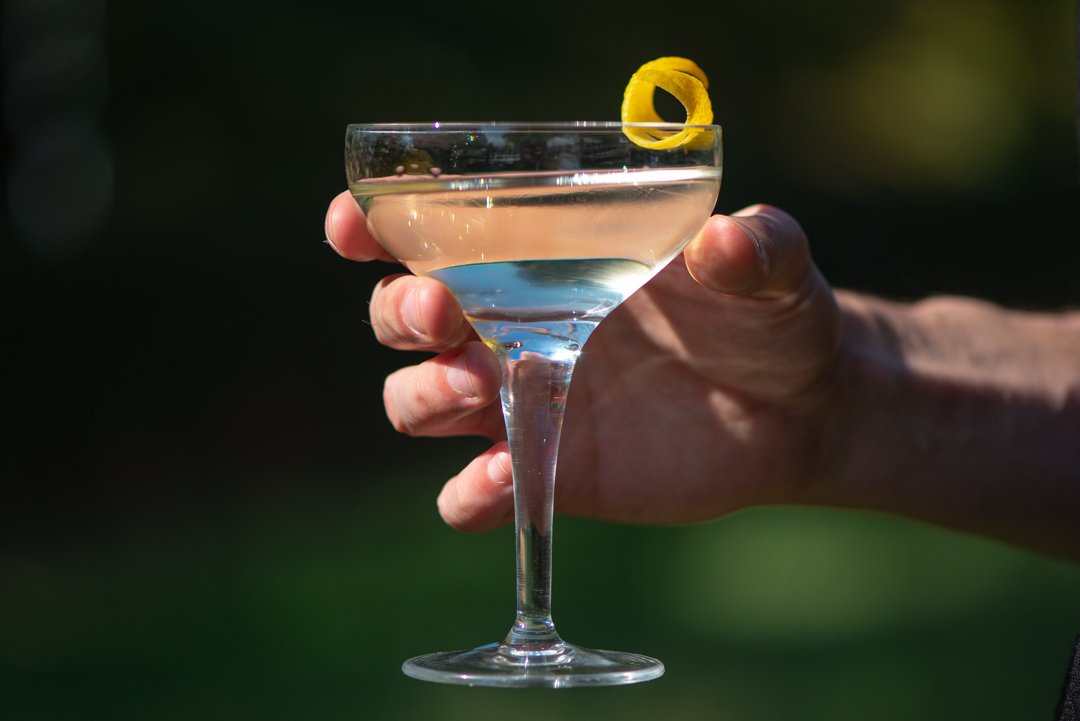My Negroni has Vermouth, the one from Torino…
Fulvio Piccinino wrote the book (literally) on vermouth, and he will tell us what is happening in this vibrant, resurging category of fortified wine.
Fulvio teaching at Esperienza Vermouth.
Hi Fulvio, I love vermouth so let's get this started! Can you briefly introduce yourself?
I am Fulvio Piccinino and I was born in 1967. After my master's degree, unable to find a professorship, I worked for a beer multinational where I held various roles. After eight years I passed behind the bar counter. After almost two decades I rediscovered my vocation for teaching. I became a teacher at the Salesian house for professional courses for bartenders for underprivileged and socially at risk kids. My great passion for history leads me to collect liqueur and distillation texts which are then used as the basis for my research. These are then used for the thematic publications which to date are six, including the one I published on Vermouth di Torino in 2015.
First of all, in a sentence, what is vermouth?
It is an aromatized wine.
Fulvio’s book.
We will be talking about Vermouth di Torino, how is that different from other vermouths?
It is the history and the prestige. No other vermouth can boast the legacy of Vermouth di Torino.
Obviously, prestige is achieved by producing an excellent product, with constant quality over time, superior to any other on the market. I am referring to products that were developed in other regions or countries. In my book I explain it in detail.
In nineteenth-century texts there are entire chapters dedicated to vermouth from Tuscany and Piedmont The former was simpler in terms of botanical composition, the herbs were left to macerate in the wine, the sweetness came exclusively from the herbs or from the sugary residue of the wine. In practice, it was a wine still influenced by the medicinal origin of vermouth. In Vermouth di Torino, the herbs were macerated in alcohol, which ensured a better extraction of the aromatic principles, and gave constant quality. The final ABV was also higher and allowed for its transportation. It was also sweetened with sucrose. Therefore it was a pleasant product with a superior aromatic complexity also thanks to more complex recipes rich in spices from all over the world.
Approximately how many Italian vermouths exist today?
It is a question that is difficult to answer. At this very moment in which you ask me the question, two new vermouths were born. Many wine cellars have taken to producing their own vermouth. Even barmen, thanks to the greater production flexibility of contractors, who have multiplied in the last 5 years, often have their own label. These are things already seen in the golden years of vermouth. We'll see who remains. Ask me the same question in 10 years.
Now, over to Roberto Bava, president of the Vermouth di Torino consortium
Roberto Bava.
Who are the members of the Vermouth di Torino consortium?
These are the members:
Antica Cantina di Calosso
Antica Distilleria Quaglia – Bèrto
Antica Torino
Arudi
Cav. Pietro Bordiga
Calissano – Gruppo Italiano Vini
Carlo Alberto
Carpano - Fratelli Branca Distillerie
Chazalettes
Cinzano – Davide Campari – Milano
Giulio Cocchi
Coop. Erbe Aromatiche Pancalieri
D.co Ulrich
Del Professore
Drapò – Turin Vermouth
Ducato
Franco Cavallero Spirits
Gancia & C.
La Canellese
Luigi Vico
Mainardi
Martini & Rossi
Peliti's
Sibona
Sperone
Starlino
Tosti1820
Vergnano
Tell me, how were you able to bring together and organize the consortium from so many brands of vermouth, all made in very different ways?
As I was already head of the wine section of the Unione Industriale of Asti, I seemed to be the logical person to spearhead the campaign. In 50 years, there had never been a formal consortium, but the time was right and we were able to found an Institute first, above all to protect the category. Still today I consider it like an Italian miracle: so many different interests and style of producers from the international global brands to the local artisans merging together to defend the common interest of saving a historical category and appellation. We have been supported by all institutions, from Regione Piemonte first, to the Italian Parliament and the EU that even showed appreciation on how the law was conceived and written.
Vermouth di Torino is today the only aromatized wine in the world with a recognized geographic Identity and a Consortium to defends its quality.
How long did it take to regulate the vermouth category?
RB: Europe recognized two appellations in 1991, Chambéry and Torino, but only one was eventually ratified in a PGO Protected Geography Origin , the “Vermouth/Vermut di Torino”, in 2017 under the Italian laws and eventually in 2019 under the final European recognition and protection.
Fulvio, you wrote a book on Vermouth and are considered an authority. The consortium president is a Vermouth maker, how is presidency of the consortium governed?
I am not part of the consortium as I am not a producer, so I don't know what the governing mechanisms are. From the outside, I hope that many more operations will be carried out on the city of Turin, perhaps a consortium communication campaign. In the 80s/90s the city also spoke with the neon signs that headed the streets with the main companies. Today it is hard to understand that Turin is the birthplace of vermouth.
What are the newest vermouths that have been recently created?
As I said, the new productions concern above all the historical and non-historic cellars which have resumed, in some cases, producing their vermouth again. In the past many Barolo makers produced vermouth, as a natural complement to the Barolo Chinato range, as well as sparkling wine makers who could thus have a constant production line and not just at full capacity during the holidays, when sparkling wines are king.
What has changed about vermouth making in the past few years? Are new styles emerging?
Vermouth di Torino has a production method that spans more than two centuries and the surprising thing is that this hasn't changed in the slightest except for some more efficient extraction methods such as ultrasound.
The authorized herbs and spices are those of tradition, therefore no Vermouth di Torino with papaya or mango is on the horizon. It’s a different story for other vermouths where we have seen the birth of some more marked flavourings, however always in the wake of tradition, perhaps taking advantage of some local excellence, such as oranges or genepy.
The new trend is linked to the communication of wine. Considering that the wineries seem to be the producers of the new wave of new vermouths, they obviously tend to emphasize the base wine, often their star product, referring to the grape variety. Vermouths were born with Barbera, Dolcetto and Nebbiolo, little used vines until just 5 years ago. In the past it was the recipe that was at the center of the project, the wine was not fundamental, the important thing is that it provided an acidic fooundation and support for the herbs. Today, the back labels of new producers also mention wine, perhaps the only way to differentiate the product, at least at first glance, in the eyes of the consumer. Then once the recipe has been chosen, it will have its fundamental part in the future desire for consumers to repeat the purchase.
Are there young Vermouth producers (Millennials or younger)?
Yes, there are many thirty-year-olds among the young generation of producers. Among the wineries and bartenders there are many millennials who have entered the fray with their products. A lowering of the quantities necessary to produce a vermouth, the launch of semi-finished products to create a recipe has created the conditions for an increase in producers who are no longer forced to produce thousands of bottles to start. Maybe some new classics will arise among some of them.
Fulvio Piccinino and the Futuristi.
Do you see a new trend in the future drinking style of Vermouth?
Exploiting the success of soda drinks, there was an attempt to launch V&T or vermouth and tonic, but I remain fond of Vermouth and Chinotto which, in my opinion, best supports the aromatic characteristics of vermouth.
At this very moment in which you ask me the question, two new vermouths were born.
To what does vermouth owe its renewed success?
History is a spinning wheel. If you are in the market, you know that it is made up of ups and downs. There were vodka bars, rum shops and now G&T bars and vermouth shops. If you make a quality product with a centuries-old history, the basis of historical blending, you are obliged to return. The fact that historical blending is back has been a huge help. The fact that the producers decided to form a consortium was fundamental.
Your favorite way to consume vermouth?
I like dry vermouth with ice and lemon zest, accompanied by some olives. I don't like things that are too sugary. If I had to drink a cocktail I would say Torino Milano (that's what they say if you're from Turin,and not Milano Torino). Obviously the vermouth must be bitter. I judge the Negroni too intense and single-note as it was created on three products whose base is a blend of herbs which is then distilled or macerated, it doesn't matter.If you don't know how to balance gin, it often covers everything and it is especially vermouth that pays the price. If I have to drink a cocktail with three ingredients I would say a Boulevardier: I find that whiskey with the softness given by corn is an excellent base on which to place vermouth and bitters that are capable of enhancing their botanical heritage.
Vermouth di Torino bianco.
The most unusual use of vermouth in a drink?
Probably Depero's Shivering Cup. It is a Futurist fantasy with a nod to mixology. A blend of vermouth and brandy in which both red and white grapes, pear slices, and two orange slices were placed to macerate for a few hours. A much more elegant sort of sangria...
Is another book on Vermouth in the works?
Historical research never stops. New things are always discovered. The book is from 2015, perhaps for the 10th anniversary, as we did for the Saperebere book, we could think of a deluxe edition...
You do vermouth making workshops, tell us how that works.
Experienza Vermouth was born in 2015 for professionals. A whole day, usually on Monday, typically the bartender’s day off, to discover vermouth, where the experience ends with the production of one's own vermouth. There is a masterclass on history, a tasting of 30 herbs and spices, a technical visit to a vermouth factory, and final production of a bottle of vermouth using professional tinctures. In the summer, there was also a visit to the wormwood and clary sage fields of Pancalieri.
After two years I found many enthusiasts among the members.
Freelancers above all who were curious to know as much as possible about vermouth.
In 2017 I created the Thursday Vermouth Experience format, an experience dedicated to enthusiasts that lasted only an hour and a half. With a reduction of the historical part, production hints on how to obtain the tinctures and final production, the part that is the most fun of the format. To date, even if we count two years of pandemic with reduced classrooms, we have reached 3,500 people who have attended the evening, including professionals and enthusiasts. It is significant since I don't think there is a permanent seminar in Italy with these numbers…
Five questions for Fulvio
Best Vermouth based cocktail?
Milano-Torino (this time in the traditional order).
Red or white?
Dry.
How much vermouth should be in a martini?
50%, otherwise it’s just a cold glass of gin.
Apart from yours, your favorite book on vermouth?
Il grande libro del Vermouth by Berta & Mainardi
If vermouth had a star ambassador, who should it be?
Luca Argentero, he is an actor from Turin, A spot with him would be perfect.
Where you can find Fulvio and Vermouth di Torino
Vermouth di Torino
Instagram: @vermouthditorino
Website: vermouthditorino.org
Fulvio Piccinino
Instagram: @fulvio_piccinino
Find Fulvio’s books for sale here.







